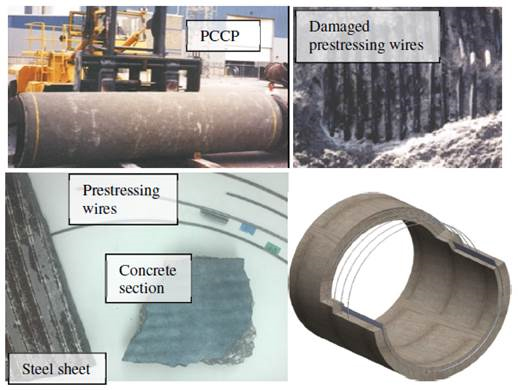Grantee Research Project Results
Final Report: Solid State Sensor for Inspection of Prestressed Concrete Pressure Pipe
EPA Contract Number: EPD13027Title: Solid State Sensor for Inspection of Prestressed Concrete Pressure Pipe
Investigators: Rensing, Noa
Small Business: Radiation Monitoring Devices Inc.
EPA Contact: Richards, April
Phase: I
Project Period: May 15, 2013 through November 14, 2013
Project Amount: $80,000
RFA: Small Business Innovation Research (SBIR) - Phase I (2013) RFA Text | Recipients Lists
Research Category: Small Business Innovation Research (SBIR) , SBIR - Water
Description:

Figure 1. (clowise from upper left) PCCP sections being installed, wires damaged by corrosion,
a schematic sketch of structure, and conduit components.
Summary/Accomplishments (Outputs/Outcomes):
To address these needs, RMD, Inc., is developing a new, highly optimized probe for PCCP based on several innovative elements. In Phase I of this program, we used a combination of computer modeling and laboratory experiments to develop and validate the individual components of this novel approach to inspection.
Conclusions:
Our Phase I results offer a compelling demonstration of the feasibility of developing a new, improved tool for inspection of PCCP pipe. Our approach has the potential to identify defects in the wires much closer to the pipe ends and with significantly less ambiguity than can be achieved with the current state of the art inspections. In Phase II of the program, we look forward to combining the different technical element conceived in Phase I, optimizing the system design and field-testing a prototype.
Supplemental Keywords:
water pipe, prestressed concrete cylinder pipe (PCCP), sensor technology, eddy current sourceThe perspectives, information and conclusions conveyed in research project abstracts, progress reports, final reports, journal abstracts and journal publications convey the viewpoints of the principal investigator and may not represent the views and policies of ORD and EPA. Conclusions drawn by the principal investigators have not been reviewed by the Agency.
